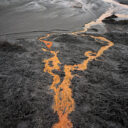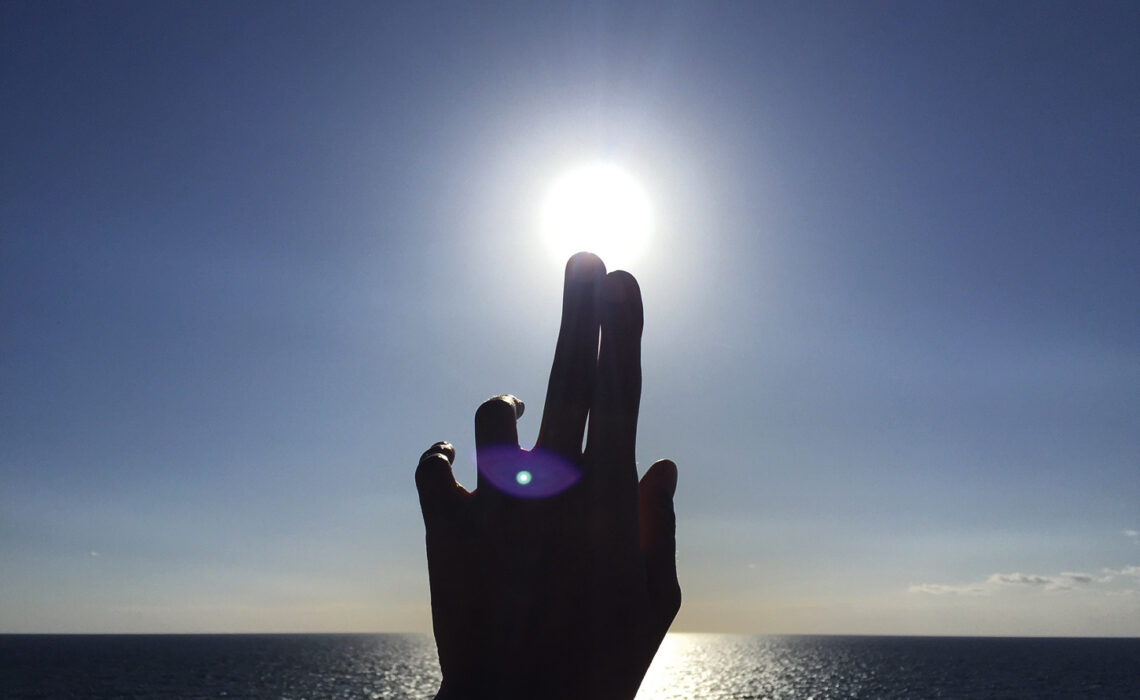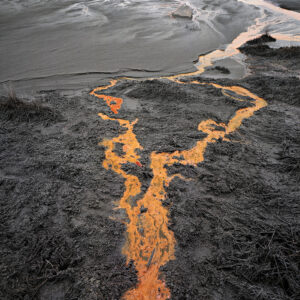Sappiamo che ci sono luoghi magnetici che funzionano come vortici energetici e aprono le porte verso una conoscenza misterica. In essi si producono scambi fra il passato e il presente, fra il microcosmo e il macrocosmo. Alcuni sono naturali, altri sono costruiti. Molti sono stati abbandonati o profanati. Altri conservano l’eco della loro forza originaria.
A Granada, per esempio, c’è una scalinata che collega la parte più alta dei Giardini del Generalife con i patios e gli stagni delle zone più in basso. È conosciuta come la Scala dell’acqua, infatti attraverso essa, modulata dalle inclinazioni e dalle circonvoluzioni della cavità nel corrimano, scorre un’acqua purissima che scende dalle sorgenti delle vette innevate e arriva fino agli stagni dei Nasridi, dove diventa uno specchio che riflette il cielo. E proprio su questa scalinata Eulalia Valldosera ha deciso di iniziare a lavorare con la luce e l’acqua. Ha sentito l’Alhambra come un crogiolo architettonico che modulava gli elementi naturali con la geometria, permettendole di accedere a spazi superiori di coscienza.
Nei suoi itinerari esistenziali e artistici, la Valldosera si è servita dei liquidi e dei loro contenitori, della luce e delle ombre, degli specchi e delle loro proiezioni, come materiali ricorrenti per alludere ai processi di coscienza, di dolore e di guarigione, sia degli strati più profondi dell’inconscio che dei transfert affettivi che depositiamo sugli oggetti e sugli spazi che abitiamo. Le sue proposte artistiche si collocano in un campo continuo di sperimentazione in cui l’installazione e la performance sono, con la fotografia e il video, gli strumenti linguistici primari. Coniuga così le tecnologie contemporanee con taccuini di disegni e annotazioni personali in cui lascia la traccia di intuizioni e riflessioni progettuali, situando sempre il corpo come parametro primordiale di connessione e trasformazione.
Con gli anni, la sua metodologia creativa è andata depurandosi e l’ha portata a intendere l’arte come una tecnologia mistica, cioè come un mezzo di trasformazione che ci avvicina a sfere sottili di conoscenza. Il suo obiettivo non è rimanere chiusa nelle sue estasi, ma utilizzarle per trasformare il mondo in cui vive. S’inserisce così nella tradizione di artisti come Joseph Beuys o Louise Bourgeois, il cui lavoro, oltre a un elevato potenziale di rinnovamento estetico, ha avuto una chiara volontà politica di guarigione personale e collettiva. Il misticismo di Beuys si riallaccia alle inquietudini del Romanticismo tedesco, mentre l’immersione psicoanalitica della Bourgeois la porta a rivisitare le istanze emotive della vita familiare che, con i suoi modelli di dominio e sottomissione, genera quel malessere per cui l’arte può rappresentare una via d’uscita.
A metà degli anni ‘90, la Valldosera realizza una serie d’installazioni che ricreano le stanze di una casa, in cui gli elementi del mobilio sono metonimia dell’attaccamento e delle proiezioni emozionali. In El comedor: el miedo a la madre (1996), i recipienti di plastica per la pulizia domestica diventano archetipi della donna come contenitore e i liquidi sono agenti tossici o di purificazione dell’immaginario personale e collettivo. In performance come Loop (1996), lo stesso corpo dell’artista agisce come contenitore o veicolo attraverso il quale fluiscono l’acqua e l’informazione.
I suoi lavori più recenti propongono un cambiamento dei modelli cognitivi dominanti che separano l’animato dall’inanimato e tracciano un ponte con le culture ancestrali in cui tale frontiera non esiste. Le sue ultime azioni presuppongono un salto qualitativo che cerca di ampliare le porte della nostra percezione. La Valldosera mette ora l’accento sul lavoro in situ e si dirige in luoghi carichi di memoria per accedere alle informazioni iscritte in essi. Il suo obiettivo è riportare nel presente i messaggi che erano rimasti imprigionati in quei luoghi e liberarli.
I suoi percorsi solitari e le sue azioni segrete vanno ben oltre il concetto di performance. Sono microazioni in cui i messaggi possono emergere da un’abitazione abbandonata, da un complesso storico-artistico, dal mare inquinato che circonda un’isola o dagli antri primigeni in cui risuonano ancora voci, saggezze e paure di altri tempi. Il suo corpo e soprattutto le sue mani diventano lo strumento per assorbire e riorientare le energie di questi luoghi, per scaricare e attualizzare le loro memorie.
Vicino a Napoli, a Cuma e nella zona vulcanica dei Campi Flegrei ci sono numerose correnti d’acqua sotterranea, laghi, fumarole ubicate nei vecchi crateri e caverne scavate dai coloni greci. L’artista ha percorso questi luoghi in cerca delle impronte di un antico sapere, quello delle sibille, donne sapienti che si prendevano cura dei raccolti, della salute della comunità e dell’armonia fra il mondo dei vivi e quello dei morti. Le sibille erano considerate le guardiane di queste terre e delle isole vicine come Capri.
In opere come Dependencia mutua (2010), la Valldosera mostrava un’immigrata che puliva una statua dell’imperatore Claudio nel Museo Archeologico di Napoli, ed esplorava i rapporti dialettici fra servo e padrone. Questa dialettica relazionale è presente anche nei suoi lavori a Capri del 2016, in cui riflette sul complesso di vittima e carnefice attraverso l’eco degli eccessi che l’imperatore Tiberio commise su quest’isola, dove si nascose fino alla fine dei suoi giorni. Tiberio si appropriò dei beni dei suoi sudditi e la sua stessa paura di essere tradito alimentò i suoi deliri di potere e le continue vessazioni nei confronti delle persone al suo servizio. La Valldosera racconta come la fissazione orale dell’imperatore e la sua dipendenza involutiva verso la madre alimentarono la sua paura della penuria pur nell’abbondanza, e di come abbia provocato immenso dolore alle persone che lo circondavano e a se stesso. E di come, attualmente, le crisi migratorie e l’inquinamento industriale continuino ad alimentare questo paradigma. La nozione di abuso si amplia a tutti noi esseri umani che, per paura di perdere l’egemonia, l’autorità o una presunta dignità, sfruttiamo, sporchiamo e distruggiamo il pianeta riempendo di sostanze tossiche le sue acque. In questo modo, siamo vittime e carnefici. Vittime perché subiamo questi disarstri ammalandoci e carnefici perché maltrattiamo la natura e gli altri esseri umani.
Quando ha iniziato l’opera Plastic Mantra, l’idea originale della Valldosera era quella di lavorare con l’acqua per esplorare le memorie che trasporta e i rifiuti che raccoglie. Il tema della plastica era già presente in opere come Del plástico y del cristal soy comensal (2016): una sorgente d’acqua collocata in una pentola tradizionale per la paella in cui, in uno strano gioco di colori e materie, si mescolavano figure di vetro, che rappresentavano alimenti, con rifiuti trovati sulle spiagge. La serie Velos plásticos (2016) consiste in una serie di fotografie in cui una persona in cima a una scala si copre con un velo di plastica emulando le madonne.
Le opere della Valldosera sono il risultato di azioni che riuniscono il mistico e il sociale. La sua arte è mistica perché implica un viaggio iniziatico per trasformare il nostro modo di stare al mondo e, allo stesso tempo, è profondamente politica perché comporta un cambio di paradigma. Fa parte di una linea di azione degli inizi del terzo millennio: la nuova “mistica attivista” che concepisce l’arte come motore di trasformazione spirituale, che è anche trasformazione materiale. La Valldosera entra così a far parte di quella schiera di visionarie creatrici che si sono lasciate guidare da tecnologie dell’anima, e cioè da mezzi che permettono di accedere a strati della realtà che ci avvicinano a un potenziale risanatore, portatore di luce e di soluzioni. Sono donne che sono state al margine delle correnti egemoniche. In ordine d’età potremmo citare Georgiana Houghton, Hilma af Klint, Emma Kunz o Agnés Martin, recentemente «ri-scoperte» e rivalutate iniziando a comprendere la profondità e il senso del loro lavoro.
Lontana dalla freddezza serializzata del minimalismo e dei suoi riferimenti ai processi di produzione industriale, dalla semplicità iconica delle immagini del pop e della cultura di massa, distante anche dalla logica dell’arte concettuale, Eulalia Valldosera considera la Terra come un archivio di memorie. Le sue opere si situano su un terreno che esplora le energie del pianeta con la chiara volontà di farci comprendere che siamo parte di un grande mistero, che dobbiamo tornare a recuperare noi stessi come esseri umani e che la guarigione è responsabilità di tutti.
Il testo completo è stato pubblicato per la mostra Plastic Mantra presso lo Studio Trisorio, Napoli, 2016-2017.
The “activist mysticism”
We know that magnetic places exist and that they work as energy vortices, opening doors to mysterious knowledge where exchanges take place between the past and the present, the microcosmic and the macrocosmic. Some are natural and others are man-made. Many of them have been abandoned or desecrated. Others preserve the echoes of their original strength.
In Granada, for instance, there is a staircase that connects the highest level of the Generalife Gardens with the patios and ponds of the lower lying areas. It’s known as the Water Stairway because of the fresh clear water which, modulated by the tilts and turns of the palisade, descends from the natural springs of the snow-capped peaks to the Nasrid ponds, where it becomes a mirror reflecting the sky. It was on this staircase that Eulalia Valldosera decided to begin working with light and water. She felt the Alhambra was an architectural crucible that modulated the natural elements with geometry, granting access to higher levels of awareness.
In her existential and artistic itineraries Valldosera has turned to liquids and their containers, to light and shadows, to mirrors and their projections, recurrent materials to allude to processes of awareness, pain and healing of the innermost layers of the unconscious and of the emotional transfers we deposit in the objects and in the spaces we inhabit. Her artistic proposals are set in a continuous field of experimentation, where the chief linguistic instruments are installations and performances, as well as photographs and videos. In this way she combines the technologies of her time with sketchbooks and notebooks where she jots down evolving intuitions and reflections, and where the body is always considered the main parameter of connection and transmutation.
Over the years her creative methodology has gradually been refined, leading her to understand art as a mystical technology, i.e., a means of transformation that brings us into contact with subtle spheres of knowledge. Her objective is not to remain locked in these forms of ecstasy but to use them to transform the world in which she lives. In this way, she follows in the footsteps of artists like Joseph Beuys and Louise Bourgeois, whose work, in addition to having an elevated potential of aesthetic renovation, also had an obvious political desire for personal and collective healing. Beuys’s mysticism was linked to the restlessness of German Romanticism, while Bourgeois’s psychoanalytical immersion led her to revisit the emotional spheres of family life that, with its patterns of dominion and submission, generates that particular malaise for which art can provide a remedy.
In the mid-nineties, Valldosera made a series of installations that recreate the rooms in a house, where the elements of furniture are the metonymy of affections and emotional projections. In El comedor: el miedo a la madre (The Dining Room: Fear of the Mother, 1996), the plastic receptacles of cleaning products become archetypes of women as containers, and the liquids are either agents of toxicity or of purification of personal and collective imaginaries. In performances like Loop (1996), the artist’s body acts as a container or vehicle through which both water and information flow.
Her most recent works suggest a change in the prevailing cognitive parameters that separate the animate from the inanimate and trace a bridge with ancestral cultures where this frontier doesn’t exist. Her latest actions constitute a qualitative leap that seeks to further open the doors of our perception. Valldosera now emphasises site-specific work and visits places charged with memory to gain access to the information they contain. Her objective is to bring messages which had been imprisoned in these places to the present and to liberate them.
Her solitary journeys and secret actions transcend the concept of performance; they are micro-actions whose messages can emerge from an abandoned flat, a historical-artistic ensemble, the polluted sea around an island or the primeval caves in which the voices, the wisdom and the fears of bygone times can still be heard. Her body and especially her hands become the instrument for absorbing and redirecting the energies of these places to release and actualize their memories.
Close to Naples, in Cumae and the volcanic area of the Campi Flegrei (Phlegraean Fields) there are numerous currents of subterranean water, lakes and fumaroles located in old craters, and caverns excavated by Greek settlers. The artist travels through these places in search of the traces of an ancient knowledge, that of the Sibyls, wise women who looked after the crops, the health of the community and the reconciliation between the world of the living and that of the dead. The Sibyls were considered the guardians of those lands and of the nearby islands like Capri.
In works like Dependencia mutua (Mutual Dependence, 2010) Valldosera presented a migrant worker cleaning a statue of Emperor Claudius in the National Archaeological Museum of Naples, and explored the dialectic relations between master and slave. These relational dialectics can also be found in the works made in Capri in 2016, where she reflects on the victim and abuser complex through the echoes of the excesses committed on the island by Emperor Tiberius, where he chose to hide for the rest of his days. Tiberius took the assets of his subjects, and his fear of being betrayed fed his delusions of power and the continuous vexations of people and his servants. Valldosera describes how the emperor’s oral fixation and his involutional dependence on his mother fed his fear of scarcity in abundance, causing great pain to himself and to those around him, and how today’s migration crises and industrial pollution continue to feed this paradigm. The notion of abuse extends to all those of us who – for fear of losing hegemony, authority or a presupposed dignity – exploit, pollute and destroy the planet, filling its waters with toxic waste, making us victims and executioners. Victims because we suffer the ravages of sickness, and executioners because we mistreat nature and other human beings.
When she began Plastic Mantra, Valldosera first thought of working with water to explore the memories it transports and the waste it gathers. The theme of plastic had already appeared in works like Del plástico y del cristal soy comensal (On Plastic and Glass I Dine, 2016), a fountain suspended in a traditional paella pan combining glass figures depicting foodstuffs with waste found on beaches in a strange game of colours and materials. The series entitled Velos plásticos (Plastic Veils, 2016), consists of a series of photographs where an individual standing on a ladder is covered in a plastic veil emulating madonnas.
Valldosera’s works are the result of actions that integrate the mystical and the social. Her art is mystical because it entails an initiatory journey to transform our way of being in the world and, at the same time, is also profoundly political insofar as it involves a change in paradigm. Her art is part of an early third millennium line of action: the new “activist mysticism” that conceives art as the driving force of spiritual transformation which is also material transformation. In this way Valldosera joins the ranks of female visionary artists who have allowed themselves to be guided by technologies of the soul, i.e., by means that provide access to strata of reality drawing us towards potential healing which brings light and solutions. These are women who have remained on the margins of hegemonic trends. By order of age we could mention Georgiana Houghton, Hilma af Klint, Emma Kunz and Agnes Martin, recently rescued or rediscovered as the depth and meaning of their work is only just beginning to be understood.
Far from the standardized coldness of Minimalism and its references to processes of industrial production, far from the iconic simplicity of images of pop and mass culture, and also far removed from the logic of Conceptual Art, Eulalia Valldosera considers the Earth an archive of memories. Her works occupy a position that explores the energies of the planet with an obvious intent to make us understand that we are part of a great mystery, that we must recuperate ourselves as human beings and that healing is our collective responsibility.
The full text was published for the exhibition Plastic Mantra at Studio Trisorio Gallery, Naples, 2016-2017.








No Comments